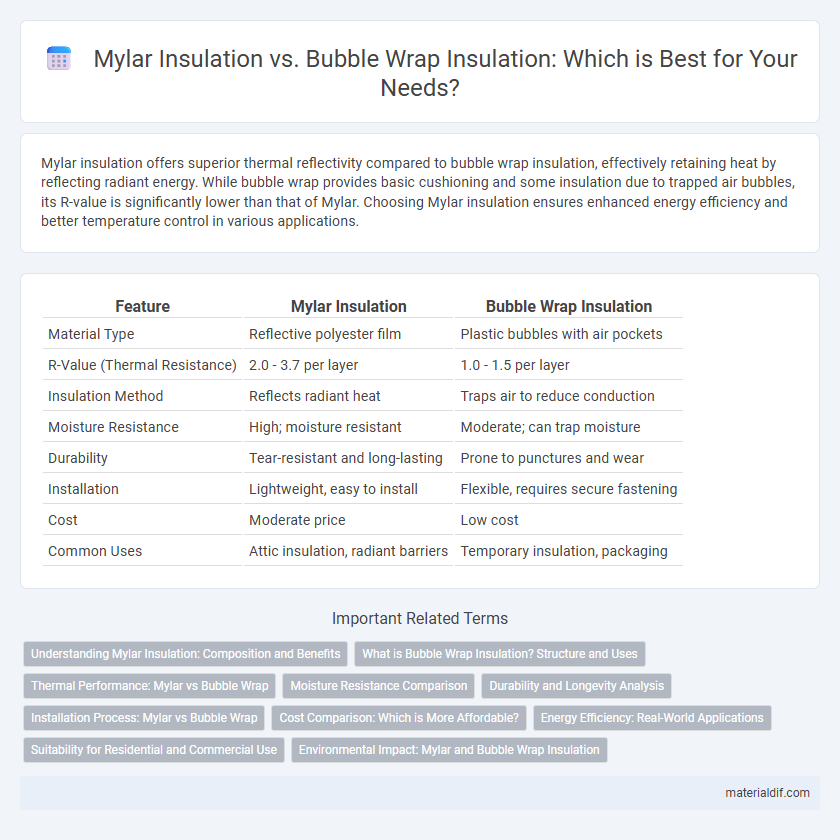Mylar insulation offers superior thermal reflectivity compared to bubble wrap insulation, effectively retaining heat by reflecting radiant energy. While bubble wrap provides basic cushioning and some insulation due to trapped air bubbles, its R-value is significantly lower than that of Mylar. Choosing Mylar insulation ensures enhanced energy efficiency and better temperature control in various applications.
Table of Comparison
| Feature | Mylar Insulation | Bubble Wrap Insulation |
|---|---|---|
| Material Type | Reflective polyester film | Plastic bubbles with air pockets |
| R-Value (Thermal Resistance) | 2.0 - 3.7 per layer | 1.0 - 1.5 per layer |
| Insulation Method | Reflects radiant heat | Traps air to reduce conduction |
| Moisture Resistance | High; moisture resistant | Moderate; can trap moisture |
| Durability | Tear-resistant and long-lasting | Prone to punctures and wear |
| Installation | Lightweight, easy to install | Flexible, requires secure fastening |
| Cost | Moderate price | Low cost |
| Common Uses | Attic insulation, radiant barriers | Temporary insulation, packaging |
Understanding Mylar Insulation: Composition and Benefits
Mylar insulation, composed of polyester film coated with reflective metal, offers superior thermal resistance by reflecting up to 97% of radiant heat, making it highly effective for energy conservation. Unlike bubble wrap insulation, Mylar's thin, lightweight structure provides excellent moisture resistance and durability without air pockets that can degrade over time. Its reflective properties enhance its utility in emergency blankets, HVAC systems, and radiant barrier applications, delivering long-lasting insulation performance.
What is Bubble Wrap Insulation? Structure and Uses
Bubble wrap insulation consists of multiple layers of polyethylene bubbles sandwiched between protective films, creating trapped air pockets that reduce heat transfer. This lightweight and flexible material is commonly used for insulating windows, packaging sensitive electronics, and providing cushioning in shipping applications. Its reflective surface enhances thermal resistance, making it an effective barrier against moisture, drafts, and temperature fluctuations in residential and commercial settings.
Thermal Performance: Mylar vs Bubble Wrap
Mylar insulation outperforms bubble wrap insulation in thermal performance due to its reflective surface that can reflect up to 97% of radiant heat, effectively reducing heat transfer. Bubble wrap provides insulation primarily through air pockets, which offer lower resistance to heat flow compared to Mylar's reflective barrier. This makes Mylar better suited for applications requiring superior thermal insulation and enhanced energy efficiency.
Moisture Resistance Comparison
Mylar insulation offers superior moisture resistance compared to bubble wrap insulation due to its metallized polyester film, which creates a nearly impermeable barrier against water vapor. Bubble wrap insulation traps air in its pockets but is prone to moisture accumulation, leading to reduced thermal efficiency and potential mold growth. For applications requiring long-term moisture protection, Mylar insulation ensures better durability and performance in humid environments.
Durability and Longevity Analysis
Mylar insulation exhibits superior durability due to its tear-resistant polyester film construction, maintaining effectiveness in harsh environmental conditions for years without degradation. Bubble wrap insulation, while offering good initial thermal resistance, tends to lose its insulating properties as the air pockets collapse and the plastic deteriorates over time. The longevity of Mylar insulation makes it a more cost-effective solution for long-term applications where sustained thermal performance is critical.
Installation Process: Mylar vs Bubble Wrap
Mylar insulation features a straightforward installation process, typically involving stapling or taping reflective sheets to walls or ceilings, which requires minimal tools and time. Bubble wrap insulation often demands more preparation, as it necessitates cutting to size and securing the air pockets against surfaces to maintain thermal resistance. Mylar's thin, flexible design allows for easier manipulation around irregular shapes compared to the bulkier bubble wrap, enhancing efficiency during installation.
Cost Comparison: Which is More Affordable?
Mylar insulation typically costs between $0.10 to $0.15 per square foot, offering a highly reflective barrier that improves energy efficiency and durability. Bubble wrap insulation ranges from $0.05 to $0.10 per square foot but lacks the long-term thermal resistance and longevity found in Mylar products. Evaluating cost-effectiveness involves balancing upfront expenses with energy savings, where Mylar insulation often provides better value over time despite a higher initial price.
Energy Efficiency: Real-World Applications
Mylar insulation outperforms bubble wrap insulation in energy efficiency by providing superior radiant heat reflection, achieving up to 97% heat reflectivity compared to bubble wrap's limited reflective capabilities. In real-world applications such as attic insulation and emergency blankets, Mylar significantly reduces heat loss and gain, enhancing temperature regulation and lowering energy costs. Bubble wrap may offer some insulation due to trapped air, but it lacks the high thermal reflectivity and durability essential for long-term energy savings.
Suitability for Residential and Commercial Use
Mylar insulation offers superior thermal resistance and moisture barrier properties, making it highly suitable for both residential and commercial applications requiring long-term energy efficiency. Bubble wrap insulation provides affordable, lightweight cushioning primarily used in residential settings for temporary or secondary insulation needs. Commercial buildings benefit more from Mylar's durability and reflective capabilities to enhance HVAC performance and reduce utility costs.
Environmental Impact: Mylar and Bubble Wrap Insulation
Mylar insulation offers superior environmental benefits due to its durability and recyclability, reducing waste compared to bubble wrap insulation, which is often single-use and made from non-biodegradable plastics. Mylar's reflective properties improve energy efficiency, decreasing heating and cooling demands that contribute to lower carbon emissions. Conversely, bubble wrap's production and disposal contribute more significantly to environmental pollution and landfill accumulation.
Mylar Insulation vs Bubble Wrap Insulation Infographic

 materialdif.com
materialdif.com